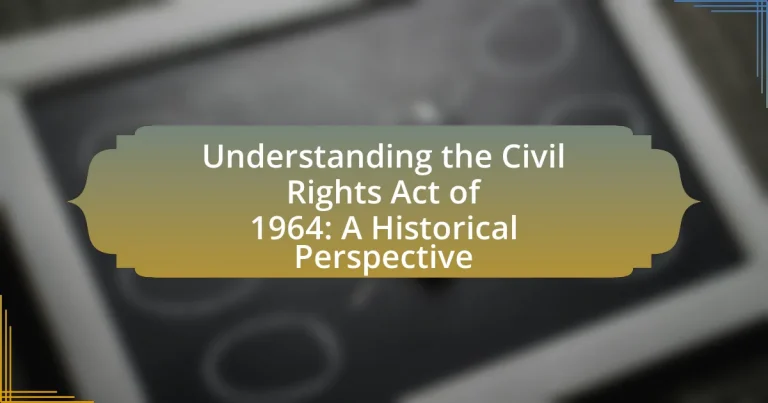The Civil Rights Act of 1964 is a pivotal piece of legislation in the United States that prohibits discrimination based on race, color, religion, sex, or national origin. Signed into law by President Lyndon B. Johnson, it aimed to eliminate segregation in schools, workplaces, and public accommodations, marking a significant advancement in the civil rights movement. The article explores the historical context leading to the Act’s creation, key figures involved in its passage, its main provisions, and its profound impact on American society. Additionally, it discusses the challenges faced during its enactment, the evolution of its interpretation over time, and its ongoing influence on contemporary civil rights movements and discussions about equality and justice.

What is the Civil Rights Act of 1964?
The Civil Rights Act of 1964 is a landmark piece of legislation in the United States that prohibits discrimination based on race, color, religion, sex, or national origin. This act was signed into law by President Lyndon B. Johnson on July 2, 1964, and it aimed to eliminate segregation in schools, workplaces, and public accommodations. The act’s significance is underscored by its comprehensive approach to civil rights, as it provided for the enforcement of desegregation and established the Equal Employment Opportunity Commission to address workplace discrimination.
Why was the Civil Rights Act of 1964 enacted?
The Civil Rights Act of 1964 was enacted to eliminate discrimination based on race, color, religion, sex, or national origin. This landmark legislation aimed to address the systemic inequalities and injustices faced by African Americans and other marginalized groups in various aspects of public life, including employment, education, and public accommodations. The act was a response to the civil rights movement’s demands for equality and justice, highlighted by events such as the March on Washington in 1963 and the violent resistance to desegregation in the South. Its passage marked a significant turning point in American history, as it provided a legal framework for challenging discriminatory practices and laid the groundwork for future civil rights advancements.
What historical events led to the creation of the Civil Rights Act of 1964?
The Civil Rights Act of 1964 was created in response to a series of historical events highlighting racial discrimination and the demand for equality in the United States. Key events included the 1954 Supreme Court decision in Brown v. Board of Education, which declared racial segregation in public schools unconstitutional, and the Montgomery Bus Boycott of 1955-1956, which showcased the effectiveness of nonviolent protest against segregation. Additionally, the violent response to civil rights demonstrations, such as the Birmingham campaign in 1963, and the March on Washington for Jobs and Freedom, where Martin Luther King Jr. delivered his “I Have a Dream” speech, galvanized public support for civil rights legislation. These events collectively underscored the urgent need for comprehensive federal legislation to address systemic racism and discrimination, ultimately leading to the passage of the Civil Rights Act.
Who were the key figures involved in the passage of the Civil Rights Act of 1964?
The key figures involved in the passage of the Civil Rights Act of 1964 included President Lyndon B. Johnson, who played a crucial role in advocating for the legislation, and civil rights leaders such as Martin Luther King Jr., who mobilized public support. Additionally, members of Congress, including Representative Emanuel Celler and Senator Hubert Humphrey, were instrumental in drafting and promoting the bill. The act was signed into law on July 2, 1964, marking a significant achievement in the civil rights movement, driven by the collective efforts of these influential individuals and their commitment to ending racial discrimination.
What are the main provisions of the Civil Rights Act of 1964?
The main provisions of the Civil Rights Act of 1964 include the prohibition of discrimination based on race, color, religion, sex, or national origin in various areas such as employment, education, and public accommodations. Specifically, Title II prohibits discrimination in public places, Title III addresses discrimination in public facilities, Title IV mandates desegregation of public schools, and Title VII prohibits employment discrimination by employers and labor unions. These provisions were established to enforce the constitutional right to equality and to eliminate barriers to civil rights, reflecting the societal demand for justice and equality during the Civil Rights Movement.
How does Title I address voting rights?
Title I of the Civil Rights Act of 1964 addresses voting rights by prohibiting discrimination in voting based on race, color, religion, sex, or national origin. This section laid the groundwork for subsequent legislation aimed at ensuring equal access to the electoral process, particularly for African Americans and other marginalized groups. The Act’s enforcement mechanisms empowered the federal government to intervene in states where discriminatory practices, such as literacy tests and poll taxes, were used to disenfranchise voters. This legislative framework was crucial in advancing voting rights and combating systemic barriers that had historically suppressed the participation of minority populations in elections.
What protections does Title II provide against discrimination in public accommodations?
Title II of the Civil Rights Act of 1964 prohibits discrimination in public accommodations based on race, color, religion, sex, or national origin. This law applies to facilities such as hotels, restaurants, theaters, and other places of public entertainment, ensuring that individuals cannot be denied service or treated differently due to these characteristics. The enforcement of Title II is supported by the federal government, which can take legal action against violators, thereby reinforcing the commitment to equality in public spaces.
What are the implications of Title VII for employment discrimination?
Title VII of the Civil Rights Act of 1964 prohibits employment discrimination based on race, color, religion, sex, or national origin, establishing a legal framework for addressing workplace inequality. This legislation empowers individuals to file complaints against discriminatory practices, leading to investigations by the Equal Employment Opportunity Commission (EEOC) and potential legal action. The implications of Title VII have been profound, as it has led to increased workplace diversity and the establishment of affirmative action policies, which aim to rectify historical injustices in employment. Furthermore, Title VII has influenced numerous court rulings that have expanded the interpretation of discrimination, reinforcing protections for various groups and shaping workplace policies across the United States.
How did the Civil Rights Act of 1964 impact American society?
The Civil Rights Act of 1964 significantly transformed American society by prohibiting discrimination based on race, color, religion, sex, or national origin. This landmark legislation led to the desegregation of public spaces, schools, and workplaces, fostering greater social equality. For instance, the Act empowered the federal government to enforce desegregation in schools, resulting in increased access to education for African Americans and other minorities. Additionally, the establishment of the Equal Employment Opportunity Commission (EEOC) provided a mechanism for addressing workplace discrimination, which has contributed to a more diverse workforce over the decades. The Act’s passage marked a pivotal moment in the Civil Rights Movement, galvanizing further activism and legislative efforts aimed at achieving racial equality in the United States.
What changes occurred in public policy as a result of the Civil Rights Act of 1964?
The Civil Rights Act of 1964 led to significant changes in public policy by prohibiting discrimination based on race, color, religion, sex, or national origin in various sectors, including employment and education. This landmark legislation established the Equal Employment Opportunity Commission (EEOC) to enforce these provisions, thereby promoting equal access to jobs and educational opportunities. Additionally, the Act mandated the desegregation of public facilities and schools, which was a critical step in dismantling institutional racism. The enforcement mechanisms included federal funding restrictions for programs that practiced discrimination, reinforcing compliance across states and localities. These changes fundamentally reshaped the legal landscape regarding civil rights in the United States, laying the groundwork for future legislation aimed at promoting equality and protecting individual rights.
How did the Civil Rights Act of 1964 influence subsequent civil rights legislation?
The Civil Rights Act of 1964 significantly influenced subsequent civil rights legislation by establishing a legal framework that prohibited discrimination based on race, color, religion, sex, or national origin. This landmark legislation set a precedent for future laws, such as the Voting Rights Act of 1965, which aimed to eliminate barriers to voting for African Americans, and the Fair Housing Act of 1968, which addressed discrimination in housing. The Act’s enforcement mechanisms, including the establishment of the Equal Employment Opportunity Commission, empowered individuals to challenge discriminatory practices, thereby fostering a culture of accountability and legal recourse that shaped later civil rights initiatives.

What challenges did the Civil Rights Act of 1964 face?
The Civil Rights Act of 1964 faced significant challenges, including strong opposition from Southern lawmakers and resistance from various interest groups. Southern politicians employed filibusters and other legislative tactics to delay or block the passage of the Act, reflecting deep-seated racial prejudices and a commitment to maintaining segregation. Additionally, public protests and violent backlash from segregationists highlighted the societal tensions surrounding civil rights, complicating the implementation of the law. The Act’s enforcement mechanisms also faced hurdles, as local authorities often resisted federal intervention, undermining the law’s effectiveness in promoting equality.
What opposition did the Civil Rights Act of 1964 encounter during its passage?
The Civil Rights Act of 1964 encountered significant opposition primarily from Southern Democrats and conservative Republicans. Southern Democrats, often referred to as “Dixiecrats,” opposed the legislation due to its provisions that aimed to end segregation and discrimination, fearing it would undermine the social order in the South. Conservative Republicans also resisted the Act, arguing that it infringed on states’ rights and individual liberties. Notably, Senator Richard Russell of Georgia led a filibuster against the Act, speaking for over 24 hours in an attempt to block its passage. This opposition was rooted in deep-seated racial prejudices and a commitment to maintaining the status quo of segregation.
How did Southern lawmakers respond to the Civil Rights Act of 1964?
Southern lawmakers largely opposed the Civil Rights Act of 1964, viewing it as an infringement on states’ rights and a threat to the social order in the South. Many Southern politicians engaged in filibusters and other legislative tactics to delay or block the passage of the Act. For instance, Senator Richard Russell of Georgia led a 60-day filibuster against the legislation, reflecting widespread resistance among Southern Democrats. Additionally, after the Act was signed into law, many Southern states implemented various forms of resistance, including the establishment of “white-only” facilities and the promotion of segregationist policies, demonstrating their continued defiance against federal mandates aimed at desegregation and civil rights.
What legal challenges arose after the enactment of the Civil Rights Act of 1964?
After the enactment of the Civil Rights Act of 1964, significant legal challenges arose, primarily concerning the interpretation and enforcement of the Act’s provisions. One major challenge involved the scope of Title VII, which prohibits employment discrimination based on race, color, religion, sex, or national origin. Courts faced difficulties in defining what constituted discrimination and how to apply the law in various employment contexts. Additionally, the Act’s implementation led to legal disputes over the desegregation of public facilities and schools, as some states resisted compliance, prompting litigation that tested the federal government’s authority to enforce civil rights protections. These challenges highlighted the complexities of translating legislative intent into practical enforcement, as seen in cases like Heart of Atlanta Motel v. United States (1964), which affirmed the federal government’s power to regulate interstate commerce to prohibit racial discrimination.
How has the interpretation of the Civil Rights Act of 1964 evolved over time?
The interpretation of the Civil Rights Act of 1964 has evolved significantly from its initial passage to contemporary applications. Initially, the Act primarily focused on prohibiting discrimination based on race, color, religion, sex, or national origin in various sectors, including employment and public accommodations. Over time, judicial interpretations and legislative amendments have expanded its scope, particularly regarding gender and sexual orientation discrimination. For instance, the Supreme Court’s 2020 decision in Bostock v. Clayton County established that discrimination based on sexual orientation or gender identity falls under the Act’s protections, reflecting a broader understanding of civil rights. This evolution demonstrates a shift towards inclusivity and recognition of diverse identities within the framework of the law.
What landmark Supreme Court cases have shaped the understanding of the Civil Rights Act of 1964?
Landmark Supreme Court cases that have shaped the understanding of the Civil Rights Act of 1964 include Heart of Atlanta Motel, Inc. v. United States (1964) and Katzenbach v. McClung (1964). In Heart of Atlanta, the Court upheld the federal government’s authority to enforce the Act against private businesses, ruling that racial discrimination in public accommodations affected interstate commerce. Similarly, in Katzenbach, the Court affirmed that the Act applied to restaurants, emphasizing that discrimination in public places had a substantial effect on interstate commerce. These cases established critical precedents for interpreting the scope and enforcement of the Civil Rights Act, reinforcing its role in combating racial discrimination.
How have changes in societal attitudes influenced the application of the Civil Rights Act of 1964?
Changes in societal attitudes have significantly influenced the application of the Civil Rights Act of 1964 by fostering a more inclusive interpretation and enforcement of its provisions. As public opinion shifted towards greater acceptance of racial equality and social justice, federal and state agencies began to more rigorously apply the Act, leading to increased protections against discrimination in various sectors, including employment and education. For instance, the rise of the civil rights movement in the 1960s, characterized by widespread protests and advocacy, created a societal demand for the enforcement of the Act, resulting in landmark Supreme Court cases such as Heart of Atlanta Motel v. United States (1964), which upheld the federal government’s authority to prohibit racial discrimination in public accommodations. This alignment of societal values with legal frameworks has led to a more robust application of the Civil Rights Act, demonstrating the interplay between changing attitudes and legislative enforcement.

What is the legacy of the Civil Rights Act of 1964?
The legacy of the Civil Rights Act of 1964 is the establishment of comprehensive legal protections against discrimination based on race, color, religion, sex, or national origin in various areas, including employment and public accommodations. This landmark legislation significantly advanced the civil rights movement by prohibiting segregation in schools and public places, thereby promoting greater social equality. The Act’s enforcement mechanisms, including the creation of the Equal Employment Opportunity Commission, further solidified its impact by allowing individuals to seek justice against discriminatory practices. As a result, the Civil Rights Act of 1964 laid the groundwork for subsequent legislation aimed at protecting civil rights and has been cited in numerous court cases that continue to shape the legal landscape regarding equality in the United States.
How does the Civil Rights Act of 1964 continue to influence civil rights movements today?
The Civil Rights Act of 1964 continues to influence civil rights movements today by providing a legal framework that prohibits discrimination based on race, color, religion, sex, or national origin. This landmark legislation established the Equal Employment Opportunity Commission, which enforces anti-discrimination laws, thereby empowering individuals to challenge discriminatory practices in various sectors, including employment and education. The Act’s provisions have inspired contemporary movements, such as Black Lives Matter and LGBTQ+ rights advocacy, by reinforcing the principles of equality and justice. Furthermore, the Act’s legacy is evident in ongoing discussions about systemic racism and social justice, as activists reference its historical significance to advocate for policy changes and reforms that address current inequalities.
What role does the Civil Rights Act of 1964 play in current discussions about equality and justice?
The Civil Rights Act of 1964 serves as a foundational legal framework in current discussions about equality and justice by prohibiting discrimination based on race, color, religion, sex, or national origin. This landmark legislation established the principle that all individuals are entitled to equal protection under the law, influencing contemporary debates on civil rights, social justice, and anti-discrimination policies. Its enforcement mechanisms, including the ability to file lawsuits and seek federal intervention, continue to empower marginalized groups in their fight against systemic inequality. The Act’s legacy is evident in ongoing movements advocating for racial and gender equality, as well as in legislative efforts aimed at expanding protections against discrimination in various sectors, such as employment and education.
How do modern civil rights activists reference the Civil Rights Act of 1964 in their work?
Modern civil rights activists reference the Civil Rights Act of 1964 as a foundational legal framework that informs their advocacy for racial equality and social justice. They often cite the Act’s provisions against discrimination in employment and public accommodations to highlight ongoing inequalities and to demand enforcement of these protections. For instance, movements such as Black Lives Matter invoke the Act to argue for systemic changes in policing and criminal justice, emphasizing that the principles of the Act remain relevant in addressing contemporary issues of racial discrimination and inequality. The Act serves as a historical benchmark, illustrating both progress made and the work still needed to achieve true equality in society.
What lessons can be learned from the Civil Rights Act of 1964?
The Civil Rights Act of 1964 teaches the importance of legislative action in combating systemic discrimination. This landmark legislation prohibited discrimination based on race, color, religion, sex, or national origin, demonstrating that legal frameworks can effectively promote social justice. The Act’s passage was a result of extensive activism, highlighting the necessity of grassroots movements in influencing policy change. Furthermore, the Act established the Equal Employment Opportunity Commission, underscoring the role of enforcement mechanisms in ensuring compliance and protecting civil rights. These lessons emphasize the need for continued advocacy, legal protections, and institutional accountability in the pursuit of equality.
How can the successes and challenges of the Civil Rights Act of 1964 inform future legislation?
The successes and challenges of the Civil Rights Act of 1964 can inform future legislation by highlighting the importance of comprehensive legal frameworks and the need for ongoing enforcement mechanisms. The Act successfully outlawed discrimination based on race, color, religion, sex, or national origin, which set a precedent for subsequent civil rights protections. However, challenges such as resistance to enforcement and the emergence of loopholes demonstrate that legislation must be adaptable and include provisions for accountability. For instance, the Act’s Title VI, which prohibits discrimination in federally funded programs, illustrates the necessity of monitoring and compliance to ensure effectiveness. Future legislation can learn from these aspects by incorporating strong enforcement strategies and addressing potential gaps to promote equity and justice effectively.
What best practices can be derived from the advocacy efforts surrounding the Civil Rights Act of 1964?
Best practices derived from the advocacy efforts surrounding the Civil Rights Act of 1964 include the importance of grassroots mobilization, coalition-building, and strategic use of media. Grassroots mobilization was exemplified by organizations like the Student Nonviolent Coordinating Committee (SNCC), which engaged local communities to advocate for civil rights. Coalition-building among diverse groups, such as labor unions and religious organizations, strengthened the movement’s impact and broadened its support base. Additionally, the strategic use of media, including televised events and press coverage, effectively raised public awareness and garnered national attention, as seen during the March on Washington in 1963. These practices demonstrate the effectiveness of organized, inclusive, and visible advocacy in achieving legislative change.


